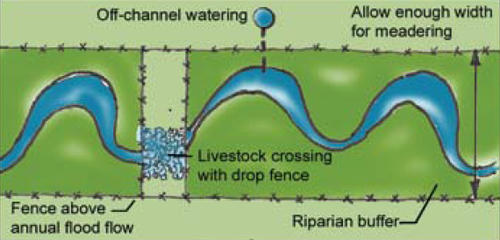Buffer stripes
Thematic sketch of buffer zone
Image Credit: USDA Forest Service Southern Reserach Station, 2008 http://nac.unl.edu/buffers/docs/conservation_buffers.pdf
Forested riparian buffers are linear multiple-row plantings of trees, shrubs and grass designed primarily for water quality and wildlife habitat purposes. They are planted strategically along rivers, streams, lakes and some wetlands to prevent potential pollutants in agricultural runoff (sediment, nutrients, pesticides, pathogens) from reaching surface waters.
Forested buffers are best suited for landscapes that were originally forested or wooded, as opposed to prairie landscapes. The width, layout and plant composition of forested riparian buffers vary depending on floodplain characteristics, landowner goals and conservation program requirements.
Environmental benefits
- protects water quality by reducing the amount of sediment, excess nutrients, pesticides and other pollutants entering streams, ditches, lakes, wetlands and other surface waters
- reduces excess nutrients and other chemicals in shallow groundwater flow
- slows flood waters and reduces stream water volume
- helps stabilize stream banks and shorelines through root absorption
- provides shade, shelter and food for fish and other aquatic species; shade is especially important for coldwater species
- provides habitat and travel corridors for diverse plants and animals; especially birds, reptiles and others that require water with adjacent woods
Practical benefits
- provides woodland recreational opportunities such as fishing, hunting, birding, hiking and camping
- provides opportunities for additional income from timber, firewood and specialty woodland products such as nuts, berries, mushrooms, medicinal plants and decorative floral materials such as flowers, boughs, stems and vines
- creates a highly visible sign of good stewardship, especially along recreational streams
- provides an alternative for frequently flooded cropland, and may reduce flood damage on adjacent cropland
-
provides a barrier against nearby dust, odor, noise or light pollution
-
adds scenic beauty and may increase property values
(back to water protection)



